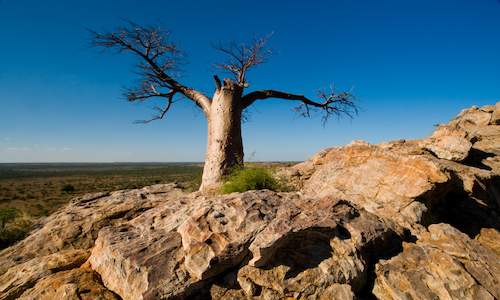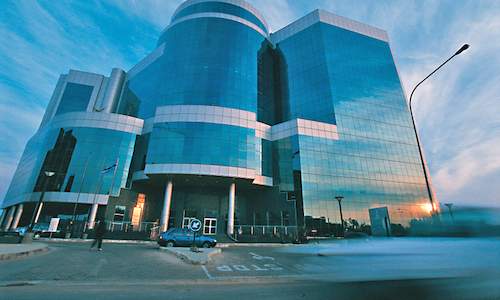
Botswana's Economy
The country is called Botswana because almost 60 percent of its inhabitants are Setswana- (or Tswana-) speakers. Botswana means 'the land of the Tswana'. The language is called Setswana and the citizens are known as Botswana.The Republic of Botswana is a multi-party democracy with legislative power vested in a single chamber of parliament. This body, the National Assembly, has a total of 44 members, 40 of whom are elected directly by the voting population in elections that are held every five years.
The members of the National Assembly elect the remaining four from a list submitted by the president. In addition, the Attorney General and the Speaker of the House sit in the National Assembly.Executive power lies with the president of Botswana who appoints a vice president and cabinet. The Presidency is limited to two five-year terms in office.
The House of Chiefs is an advisory body that acts as a support to the National Assembly, particularly on issues relating to the rural areas and traditional life. This body has members, comprising the eight chiefs from the principal groups within Botswana and seven who are in turn elected by these members.Diamonds are the major component of the economy, contributing almost 70 percent of foreign earnings and approximately 32 percent of GDP. Other metals and minerals mined in the country include copper, nickel, coal, cobalt, soda ash and gold. Industry comprises almost 20 percent of GDP, with textiles, food and beverage processing, light engineering and leather and related craft production forming the major components of this sector.Agricultural production, primarily of beef, used to comprise over 45 percent of GDP at independence in 1966, but this has now fallen below four percent. The sector is, however, the country's largest employer as it provides some source of income for almost 80 percent of the population.
The country receives subsidies from the European Union for its beef, which goes mainly to the United Kingdom, Norway, Denmark, Italy and Greece. The national herd consists of almost 3 million head of cattle.Tourism is the fastest-growing sector of the economy and the one that supports the less developed northern and western regions of the country. Although its contribution to GDP is still below 20 percent, it is a large employer, the second-largest foreign exchange earner, and has been responsible for creating enormous knock-on benefits to the secondary economy. This sector offers great potential for Botswana in the future.
Land tenure falls into three broad categories: communal or tribal land comprises 71 percent of the country, State land (which includes all national parks and reserves) 23 percent, and freehold land occupies six percent, mostly in the east and around Gaborone, Francistown and Ghanzi. All citizens living in communal areas are entitled to land free of charge for residential, agricultural and commercial purposes.In general, population density increases from west to east, with almost 80 percent of the population living in the eastern corridor from Francistown to Gaborone and their surrounding towns. While the average density is just over 2.6 people per square kilometre, in parts of the central regions it is under 0.5 persons per square kilometre, and as high as 450 in the cities and towns of the east and south.
Education is free and, although strongly encouraged, is not compulsory. There are over 730 primary schools and 270 secondary schools, which provide 12 years of education and the highest teacher-pupil ratio in Africa. The country has over 50 colleges and technical education facilities for school-leavers, and one university. The literacy rate is approximately 73 percent.The legal system is based on Roman-Dutch and customary law. It is administered through a number of regional magistrates' courts operating under the High Court and a Court of Appeal. Customary Courts are recognised, and they deal with minor issues within rural communities. The judiciary is viewed as being fully independent of the State, and the country's ultimate penalty is that of death by.
Botswana was a founder member of the Southern African Development Community (SADC) - the secretariat remains in Gaborone - and the country is also a member of the United Nations, the African Union, the Commonwealth, the Non-Aligned Movement, the Southern African Customs Union and the World Trade Organisation.The national flag comprises a simple grid pattern with the colours blue, black and white. Blue, which represents rain and water, dominates the flag, as it is a symbol of the prosperity this precious natural element brings to the country. The black and white stripes are symbolic of the harmony amongst the various race groups. The zebra, which appears on the coat of arms, is the country's national animal. Botswana has no national bird or flower.
Are diamonds forever?
Diamonds have earned Botswana its wealth and, along with this, the status of being recognised as one of the world's most successful economies. The first kimberlite pipes were discovered in 1967 at Orapa and production commenced in 1971.Two other major mines followed: Letlhakane in 1977 and Jwaneng, which produces the most carats, in 1982. Presently there are more than 200 kimberlite pipes at 12 different fields, and most mining is open-pit or at a shallow level, making for some of the lowest-cost mining worldwide.All three diamond mines are operated by DEBSWANA, which is a 50-50 partnership between the Botswana Government and De Beers of South Africa. With just over 22 percent of world production, Botswana is the leading producer of gem-quality stones in the world.
Over 28 million carats were produced last year. However, the substantial impact that diamonds have had on Botswana's success has resulted in the government becoming overly dependent on this single-source revenue.Contrary to the popular ads, diamonds are not forever, and the biggest challenge facing the country and its leaders is to diversify the economic base, broaden the sources of government revenue and promote sectors that provide substantial job creation and spread wealth more evenly.
While the diamond industry is the largest foreign exchange earner and contributes a large percentage of GDP, it employs relatively few people and does not offer a solid platform on which to base future growth and development.At present values, reserves are forecast to last only another 35 years. Fortunately, political leaders and entrepreneurs are aware of this, and they have been attempting to attract manufacturing and related secondary and tertiary industries to the country. Sectors that have been targeted include light engineering, food and beverage processing and textiles.
Good governance
In the 2003/04 Competitiveness Report conducted by the World Economic Forum (WEF), Botswana was ranked first amongst all African countries surveyed. The study looked at issues such as the rule of law, impressions of corruption and the enforcement of contracts for an overall assessment of competitiveness and prospects for economic growth. Generally, the country has always had an excellent reputation in this regard, which has been one of the major factors in its overall success.Botswana's political stability and success have been fuelled by rapid economic and social development. Ranked as one of the world's poorest countries at independence in 1966, with the cattle industry its only viable and productive sector, it has become a middle-income country that is the world's leading producer of gem-quality diamonds.There are three large open-cast diamond mines: Jwaneng, Orapa and Letlhakane, which together produce over 22 percent of the world's gem-quality diamonds. Gaborone offers visitors all the modern conveniences expected in a capital city. The High Court in Francistown.
This is on one of the busiest routes for trucks transporting goods to central Africa. Plans are afoot to replace the ferry with a bridge sometime in the future - but this is entirely dependent on the political will of the 4 southern African governments whose borders meet at Kazangula.
History of Botswana Series

Author Photographer: Ian Michler
A History of Peace
Modern-day Botswana
From Dung to Diamonds

 Botswanas history is is nowhere near as turbulent as other African states. Today, with a stable economy, and an equally stable society it is...
Botswanas history is is nowhere near as turbulent as other African states. Today, with a stable economy, and an equally stable society it is... Botswana has been blessed with great leaders, men who have guided the nation and its people with vision and commitment. While the discovery ...
Botswana has been blessed with great leaders, men who have guided the nation and its people with vision and commitment. While the discovery ...